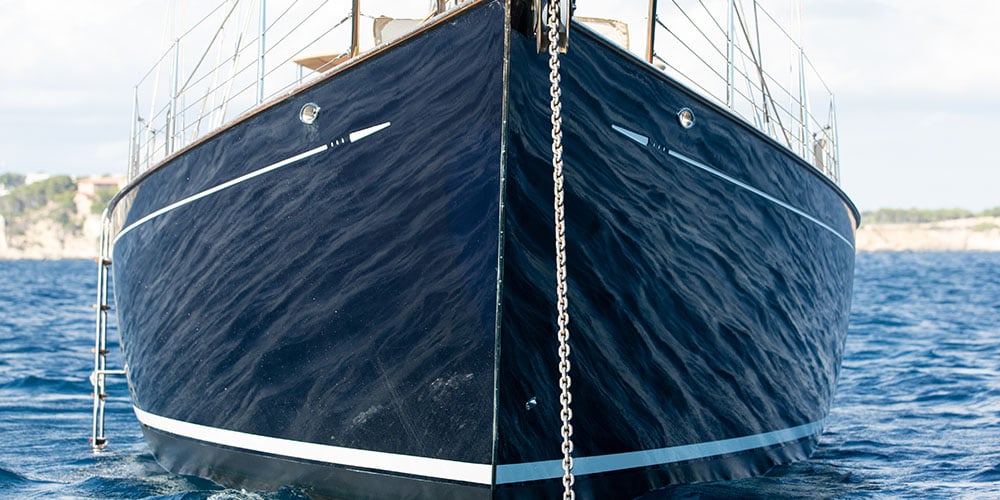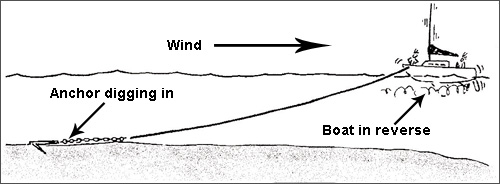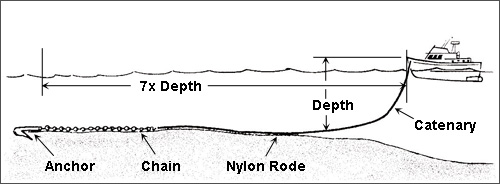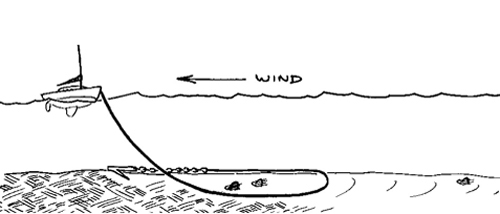
What Anchors Do
Anchors dig into the seabed to hold a boat in position. Your anchoring gear serves a safety role by keeping boats out of the surf or off the rocks. They also allow boaters to secure the boat temporarily while fishing, having lunch or spending the night. We'll walk you how anchors work, how to set, reset and make sure you have the right scope, using different anchor types depending on bottom conditions and more.
How Anchors Work
When an anchor penetrates the surface of the seabed, suction generates resistance, created by the bottom material plus the weight of the material above the anchor. As the boat pulls on the anchor rode, the anchor digs in deeper, creating additional resistance. In rocky bottoms, anchors can't dig in, but rather snag on protrusions and hold precariously.
Setting

To ensure that an anchor "sets" well, apply tension to the rode so the anchor penetrates the bottom. Do this by making fast the line and applying power in reverse. If your boat moves, reset the anchor and try again.
Many boaters make only a half-hearted attempt to set the anchor by putting the boat in reverse for just a few seconds. To be sure the anchor is set you must put a reasonable strain on the rode for a reasonable length of time. Your boat should surge forward when you back off the power, indicating that you have put some strain on the rode to test the anchor set. We know of no way to ensure that your anchor will hold other than by pulling on it hard.
Scope

Scope is defined as a ratio of the length of an anchor rode from the bit to the anchor shackle and the depth of the water under the the bow of the boat measured from deck height. Most anchoring texts and anchor manufacturers agree that a scope of 7:1 achieves the anchor's designed holding power, and more scope is better than less. In theory, 7:1 scope is great, but at a crowded anchorage most cruisers scoff at the idea of paying out more than 3:1 or 4:1; there just isn't that much space for boats to swing. When an anchor is securely set you can consider shortening scope in a crowded anchorage.
Once an anchor has been set, it will almost always hold the same amount of tension that was used to set it, even if the scope is reduced. This means that you can pay out long scope, pull hard on the anchor rode using the engine and then shorten scope to reduce swinging room. However, if your boat swings and the anchor has to reset itself, it will have to do so at a reduced scope. This is known as Anchoring Russian Roulette.
Resetting
It's fairly easy to set an anchor when wind and current come consistently from one direction, but if they veer, some perform better than others under varying angles of pull. Any anchor can become dislodged from the seabed if the boat swings far enough. Four techniques can alert you when your boat swings:

- If you have an anchor alarm on your chartplotter, set it so it alerts you if the boat swings too far from the position where it was when you set the anchor.
- If you have an electronic compass or autopilot, set the course alarm so it alerts you if the boat's heading changes radically.
- If you have alarms on your depth sounder set maximum and minimum alarms to alert you if the water depth changes significantly, indicating that you are drifting either away from or towards the shore.
- Stand an anchor watch. It is a good practice to take bearings on prominent landmarks when you anchor so you can detect any subsequent change in position.
Anchoring Techniques With Two Anchors
Other Articles on Anchoring
Anchoring Bow and Stern
In tight anchorages, you may need to limit your boat's tendency to swing at anchor. By dropping an anchor close to the beach and a second anchor in the opposite direction, you can locate the boat precisely in the anchorage. You can also use the tension on one rode to help set both anchors.
Two Anchors Off the Bow
Bob Ogg, co-inventor of the Danforth anchor, recommends setting one anchor into the wind or current, and a second anchor 180° away. Then take both lines to the bow of the boat. This allows the boat to swing around in a relatively small arc, yet will allow the boat to pull against an anchor without causing it to reset when wind or current change.
Assessing Bottom Conditions
Anchors need to develop enough resistance in the seabed to withstand the environmental forces on the boat—the wind and the waves. An anchor's ability to develop resistance is entirely dependent on its ability to engage and penetrate the seabed. We have participated in several anchor tests, and despite varying results, there always seems to be one undeniable conclusion: the selection of a suitable bottom for anchoring is a much more critical factor than the design of the anchor. So how do you choose the right type of anchor? You must take expected bottom conditions into account. Here is an analysis of potential options, based on the seabed.

Fortress Premium Fluke Anchors are highly regarded for their holding ability in soft bottoms.
Sand:
Fine-grained sand is relatively easy for anchors to penetrate and offers consistently high holding power and repeatable results. Most anchors will hold the greatest tension in hard sand. Best in sand are the lightweight Danforth-style anchors like the West Marine Traditional and Fortress anchors.
Mud:
Mud has low shear strength, and requires anchor designs with a broader shank-fluke angle and greater fluke area. This allows the anchor to penetrate deeply to where the mud has greater shear strength, and also presents more surface area in the direction of pull. Mud is frequently only a thin layer over some other material, so anchors that can penetrate through the mud to the underlying material will hold better. Fortress anchors have superior holding power in mud, because they can be converted to a broad fluke angle.
Rocky bottoms:
Holding power is more dependent on where you happen to drop the hook than on the type of anchor you have. Plow-shaped or grapnel-type anchors, with high structural strength to sustain the high point loads generally work the best. These include the Bruce, CQR, or Delta, as well as the old-fashioned Fisherman style anchors.
Shale, clay and grassy bottoms:
Tough bottoms for all anchor designs. The weight of the anchor, more than its design, may be the most important factor in penetration and holding power. CQR and Delta anchors are thought to be good due to their ability to penetrate the vegetation. However, these conditions have a high probability of false setting, due to the anchor catching on roots and protrusions, rather than something solid.
Anchoring Tips
Despite claims to the contrary, no single anchor design is best in all conditions. Boaters voyaging to areas where there is a specific type of bottom must carry an anchor(s) suitable for that bottom. For all but very small boats, we recommend that all boats carry at least two anchors for the following reasons:
- You will have another if one anchor is lost
- Different anchor types work best for different conditions
- Two anchors allow you to anchor bow and stern in tight anchorages
Inspect your entire anchor system frequently for chafe, loose shackles, and bent flukes. The system is only as reliable as its weakest component. Replace your anchor chain or anchor line if they show significant signs of wear.
Store at least one anchor so that it can always be used immediately. Even the strongest anchor won't do you any good if you can't deploy it. Quickly deploying even a small anchor can keep you from going further aground.
We recommend adding an anchor roller to your boat if it is not equipped with one already. An anchor roller makes dropping and weighing anchor easier, helps reduce chafe and prevents you from dinging or scratching your boat when droping or weighing anchor.
FAQ: How to Anchor Securely
What type of anchor should I use for my boat?
The best anchor depends on your boat size, the seabed type, and conditions. Popular choices include fluke anchors for sand and clay, plow anchors for varied bottoms, and mushroom anchors for kayaks and dinghies moored in calm waters.
How much anchor rode should I let out?
Opinions vary, but a scope of 7:1 (seven feet of rode for every foot of water depth) is adequate for most conditions. In a calm anchorage, scope of 5:1 may be sufficient. In rough, windy conditions, more scope is better.
What’s is the advantage of an all-chain anchor rode?
Chain provides better abrasion resistance and weight to keep the anchor set.
How can I ensure my anchor is set properly?
After deploying the anchor, back down the boat slowly while keeping tension on the rode. Look for signs of the anchor digging into the bottom, such as resistance or the boat staying in position.
What are the signs of a dragging anchor?
There will always be some movement as your boat swings at anchor. However, most gps units can be programmed to sound an alarm if your boat moves beyond a prescribed radius. Apart from that, keep an "anchor watch" and monitor your boat's position in relation to landmarks.
Do I need a secondary or backup anchor?
Yes, carrying a secondary anchor is useful for storm conditions, anchoring in tight spaces, or setting a Bahamian moor (two anchors at different angles) to limit swinging.
How do I retrieve a stuck anchor?
Drive the boat forward slowly in the opposite direction of the set. If it doesn’t release, use a trip line or pull at different angles to free it.
What should I consider when anchoring overnight?
Check the weather forecast, ensure adequate scope is deployed, and set an anchor alarm on your GPS to detect any movement. Test the anchor set before turning in for the night or leaving your boat unattended.






